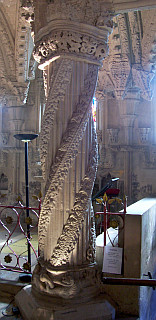
United Kingdom
Rosslyn

Located a few miles south of Edinburgh, in Roslin, Rosslyn Templar chapel (the spelling is different from the name of the village) is associated with the mysteries raised by its many symbolic sculptures. In the Middle Ages, sculptures and stained glass windows were designed to instruct the faithful who could not read, but the profusion of details and symbols is so important here that it is a priori not unreasonable to ask the question of the existence of esoteric messages. The chapel dates back to the middle of the 15th century (probably 1446) and would have become the college of St. Matthew if it had been achieved. According to a rumor it would be a Templar chapel, but it is rather unlikely. About a connection with Freemasonry, if it is not formally established, it is not excluded either (and some people support this thesis).
To show some of its "jewels", let us start with one of the pillars, nicely decorated, and called the apprentice pillar. According to a 18th century legend, this pillar would have been carved by a young apprentice while his master mason was absent. When the latter returned he would have become mad with jealousy and would have killed his apprentice !
In Rosslyn, there is of course a lot of religious symbols such as the fallen angel Lucifer, but maybe also pagan symbols such as the "green man" which represents a human face with foliage often growing out from his mouth. There are several representations of that kind in the chapel and they could correspond to the months of the year.
Even more amazing, our guide tells us there are sculptures looking like new world plants (ears of corn, cactus) which would have been carved here 100 years before the official discovery of the new world by Christopher Columbus... Some people believe in a theory which states that the Knights Templar who owned a large fleet based at the port of La Rochelle and managed to save it before their arrest (although no one knows what happened to it) would have been several times in America. And William Sinclair (a noble descendant of the Norman family St. Clair), the founder of the chapel, would have been initiated and would have made this trip. Overall it seems difficult to give credence to this story because there is no evidence that William Sinclair had connections with the Templars on one hand (his family would have even testified against the Templars in 1309) and on the other hand those sculptures can also match other plants (wheat for instance)... However, going back to the discovery of America, it is no longer any doubt that the Vikings had gone there via Greenland centuries before Columbus. As for the Templars ?
About William Sinclair, we can add that he would have been Grand Master of Masons according to several sources. What is certain is that one of his descendants was Grand Master of the Grand Lodge of Scotland but it was a long time after in 1736-1737.
Not to be missed : the angel with the bagpipe... Also remarkable are the "cubes" that decorate the edges of the pillars. There are 213 in all with a pattern on top of each one. According to an interpretation, these patterns (there are 13) would be reproductions of sound waves (obtained by looking at sand after the vibration of a note). The study of these vibrations is called cymatics and the patterns are called forms of Chladni, but is it really the case in Rosslyn ? However, two people, Thomas and Stuart Mitchell created a tune named the Rosslyn Motet based on these sequences.
To finish up : a frieze represents six deadly sins and a virtue (charity), whereas on the opposite, another frieze represents six virtues and a sin (greed). This inversion is certainly not a mistake but must have a meaning : no one is all bad or all good ? or charity can redeem all sins ?
With all these mysteries, it is no wonder the place was used in the novel "Da Vinci Code" by Dan Brown. But first and foremost it is a church and we must not forget it !
